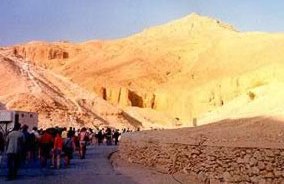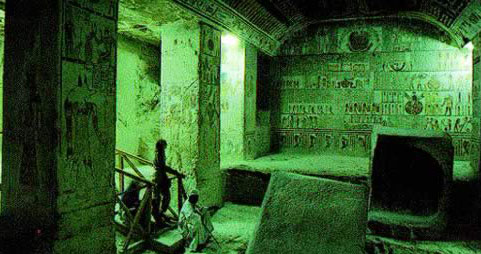Luxor Area and the Tombs of the Egyptian Kings and Queens
Thursday, December 23, 2010
In the morning we take the “included” Luxor Hilton buffet breakfast. No kidding around in this hotel. Definitely 5-star.
On the road at 7:30, we are headed to the Valley of the Kings. If you remember that the Luxor area was used mostly in the Late Period Kingdom that means that here we are talking about the tombs of the later kings, starting around 1500 BC. Luxor is on the east side of the Nile, on the sunrise side, and was used for activities of the living and temples. The Valley of the Kings, with tombs, was on the east side, the sunset side, indicating the end of life or the beginning of the afterlife. The basic idea here is that the king would start building his tomb as soon as he was coronated. So if a king lived 50 years, the tomb would be completely finished, all trimmed out with carvings and paintings. However if he died early, they would have 70 days while he was being mummified to finish the tomb. This would mean they would have to hurry, leaving unfinished rooms behind, and sometimes not carving the walls, but only painting.
The tombs are tunnels that go down into the ground, inclined at a moderate slope, perhaps 20 degrees. The size is about 10-12 feet wide and 12-15 feet high. Like other creations of the Egyptians, the wall here are incredibly well- crafted, and very straight and flat. It is difficult to comprehend how they could dig a tunnel down into solid rock for perhaps 200 feet, with perfectly straight walls, using only the basic tools they had at that time, and making virtually no mistakes. The walls and rooms are first roughed out, and then slowly increased in size until finished. So that means that carvings and reliefs in decorations had to be planned out in advance, and mistakes were difficult to correct.
crafted, and very straight and flat. It is difficult to comprehend how they could dig a tunnel down into solid rock for perhaps 200 feet, with perfectly straight walls, using only the basic tools they had at that time, and making virtually no mistakes. The walls and rooms are first roughed out, and then slowly increased in size until finished. So that means that carvings and reliefs in decorations had to be planned out in advance, and mistakes were difficult to correct.
We have not talked about relief carvings. The Egyptians created two times, regular and reverse. You have seen in some of the temple surfaces in previous posts how they created hieroglyphic characters and figures in rock. These were carved and then painted. If you carve into the rock and leave scratches and grooves, this is normal relief. If, instead, you leave raised areas which are the detail, surrounded by flat areas that are deeper into the rock than the characters and drawings, this is reverse relief. It is much more difficult, and not forgiving. So in the tombs you are expanding the tunnel carved out of the rock, and stopping where you want the perfectly flat wall to be, but leaving behind the raised reverse relief that you want to be the drawings and letters, as you flatten the surface of the rock behind the raised part. And all of the raised surfaces are perfectly parallel and flat. You are walking down a tunnel with this sort of thing on very large wall areas on three sides of you. Have you tried that yourself lately?
We were not allowed to bring cameras into any of this. The idea is to prevent you from exposing the ancient paintings from flashes. In addition, I think there is an element of wanting to prevent the world from spreading tons of pictures around. In any case, we have no pictures of any of it. I have included here a shot from the Internet to give you an idea.
 I don’t remember which kings’ tombs we visited. There are about 25 tunnel tombs, and various of them are open at any time. You ticket allows you to visit 3, and our guide picked what he thought were the best available at the time. I believe one was from Ramses VI, but which is which is not super important. One will be more ornate, the other unfinished to a degree, and one we entered went much farther down into the rock, leaving you wondering why. There were varying numbers of rooms, all in a row, and some chambers to the side for various purposes. The walls are decorated with pictures of the pharaohs, always pointing down towards the afterlife, and other people point up towards the living.
I don’t remember which kings’ tombs we visited. There are about 25 tunnel tombs, and various of them are open at any time. You ticket allows you to visit 3, and our guide picked what he thought were the best available at the time. I believe one was from Ramses VI, but which is which is not super important. One will be more ornate, the other unfinished to a degree, and one we entered went much farther down into the rock, leaving you wondering why. There were varying numbers of rooms, all in a row, and some chambers to the side for various purposes. The walls are decorated with pictures of the pharaohs, always pointing down towards the afterlife, and other people point up towards the living.
 After the Valley of the Kings, we started towards the Valley of the Queens, about 10 miles north. But first, we stopped along the way at the Mortuary Temple of Queen Hatshepsut. Queen starting in 1479 BC, Hatshepsut built this temple set into the hills on the east Nile. It was defaced and mostly destroyed by hateful future kings. It has been well restored and its three wide terraces attract both tourists and locals. It must have been some sort of holiday, because there were countless school children
After the Valley of the Kings, we started towards the Valley of the Queens, about 10 miles north. But first, we stopped along the way at the Mortuary Temple of Queen Hatshepsut. Queen starting in 1479 BC, Hatshepsut built this temple set into the hills on the east Nile. It was defaced and mostly destroyed by hateful future kings. It has been well restored and its three wide terraces attract both tourists and locals. It must have been some sort of holiday, because there were countless school children there that day, We were there on in droves 50 at a time. I captured a picture of a group that I have included here. You can see the standard dress of the girls includes a he3ad scarf, and the kids all have heavy jackets on. Though I am in shirt sleeves and very comfortable, it is winter for them, and they consider 65 degrees to be fairly cold. It is usually 110 and up here during most of the year.
there that day, We were there on in droves 50 at a time. I captured a picture of a group that I have included here. You can see the standard dress of the girls includes a he3ad scarf, and the kids all have heavy jackets on. Though I am in shirt sleeves and very comfortable, it is winter for them, and they consider 65 degrees to be fairly cold. It is usually 110 and up here during most of the year.
Valley of the Queens is like Valley of the Kings, except the tombs are smaller here. However, frequently the painting is more vivid because they did not spend as much time doing intricate carvings, preferring the quicker art of painting. Again, no cameras!
 On the way back we stopped at the Collossi of Memnon, two statues of Amenhotep III that the pharaoh built in front of his mortuary temple. The temple is gone but the statues are huge and beautiful.
On the way back we stopped at the Collossi of Memnon, two statues of Amenhotep III that the pharaoh built in front of his mortuary temple. The temple is gone but the statues are huge and beautiful.
Khassam and Muhhamad dropped us at Steigenberger Hotel for lunch and to wait for the trip back to the airport for our return flight to Cairo. This hotel is sort of a little piece of Italy/Greece/Lebanon/Vienna wrapped up in one, with kind of a bistro central area. I don’t know exactly what to say, except they had wireless Internet access, and we had our computers, so that worked out. At the restaurant we backed off from Egyptian food and had Coke, Fanta orange, a hamburger, a BTC (bacon, tomato and cheese).
Back in Cairo at 7, again we copped out of the effort to go out to Egyptian food, and supped at Harry’s Bar, attached to the hotel. Carafe of white wine, fish and chips and another burger. We did not expect it, but Harry’s bar turned out to be a British pub, and it is an uphill battle to find something exciting to eat from England.
Another long day, and an early night to bed. Tomorrow, off to Alexandria.